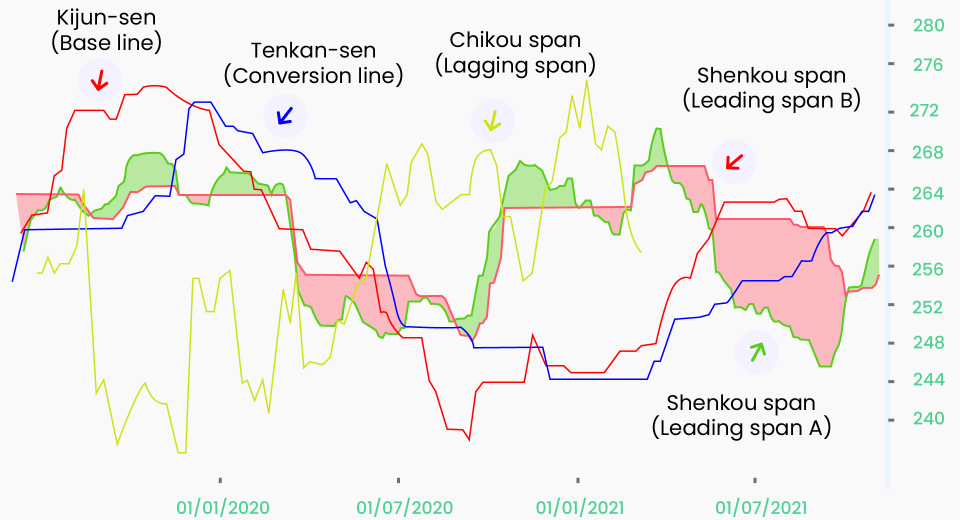5 Best Oscillator Indicators for Trading Like a Pro

The technical analysis of asset price movements is often done with a combination of indicators, including candlestick patterns, trend indicators, volume indicators and oscillators. Together they help traders make informed decisions about entry and exit points and the size of positions they should take.
Here’s a look at the top 5 oscillator indicators – those that traders use to discover oversold or overbought market conditions. A distinguishing factor about oscillators is that they are not overlaid on the price chart but displayed separately, mostly at the bottom of the chart.
- Relative Strength Index (RSI)
RSI signals how the momentum for a specific asset is changing in the market. In short, it measures the speed and degree of change of price movements. Experienced traders tend to use the RSI for trending markets. A common way to use it is to first identify the potential support and resistance levels, and then apply the indicator.
Interpreting RSI
RSI oscillates on a scale of 0 to 100. A value above 70 indicates overbought conditions, while a reading below 30 indicates an oversold market. During a trending market, 30 and 70 are considered support and resistance levels.
A common strategy used by traders is to take a long position when the RSI breaches 70 and go short when it breaches 30. Hawkish traders often use 60 and 40, instead of the standard values, in combination with other indicators.
RSI is also used to indicate divergence. When the RSI moves in the opposite direction to the momentum, it is considered a signal of weakening momentum strength.
Calculating RSI
First, use N periods and calculate the difference between opening and closing prices for each. Then, separate the gains from the losses and calculate the average price again and the average loss. The ratio of average gain to average loss is the relative strength (RS of momentum).
RS = (Avg Gain)/ (Avg Loss)
The formula for the RSI is:
RSI = [100 – (100/(1+ RS))]
- Moving Averages Convergence and Divergence (MACD)
MACD is one of the most popular trading oscillator indicators. It provides multiple trend signals and helps traders discover trend direction and gauge momentum strength. MACD uses exponential moving averages across the 12-period and 26-period price movements. It then converts the two into an oscillator. It is most commonly used to signal trend reversals.
Interpreting MACD
The convergence of the MACD lines shows a loss in momentum strength, while a divergence shows that the momentum is gaining strength.
The MACD line crossing the 9-period EMA from below is considered a buy signal. It is also called a bullish crossover. On the other hand, when the MACD line crosses the 9-period EMA from above, i.e., a bearish crossover, it is considered a signal to sell.
A histogram is drawn using the two lines to show convergence and divergence.
Calculating MACD
MACD Line = 12-Day EMA − 26-Day EMA (shorted period EMA – Longer period EMA)
Signal Line = 9-Day EMA of the MACD line
MACD Histogram: MACD line – Signal line
- Stochastic Oscillator
This indicator calculates the current price range over a certain number of periods. It tracks whether, during an uptrend, the price is making new highs or, in a downtrend, making new lows. It moves faster than the price and oscillates between 0 and 100. It uses slow (%D) and fast (%K) stochastic values.
Interpreting the Stochastic Oscillator
Oscillator values over 80 indicate that the asset is overbought, while a value below 20 signals oversold conditions.
Using Only %K
When the oscillator value drops below 20 and rises back up, it is considered a buy signal during an uptrend. However, a rally above 80 during an uptrend is considered inconsequential.
During a downtrend, when the oscillator breaches 80 and then drops back below it, traders consider it a signal to take a short position.
Using %K and %D Together
%K crossing over %D in the overbought zone is called a bullish crossing, which traders use as a buy signal. But %K crossing below %D in the oversold area is called a bearish crossing, which is considered a sell signal.
Calculating Stochastic Oscillator
The number of periods, i.e., N, is usually taken as 14.
The current value of the stochastic indicator is called %K and is calculated using the most recent closing price (C), lowest trading price in the last 14 periods (L14), and highest trading price during the duration (H14).
%K = ((C−L14) / (H14−L14)) × 100
%D = 3-period moving average of %K
Here the 3-period is also called the smoothening period.
- Commodity Channel Index (CCI)
This indicator was initially designed with a focus on the commodity market but is now applied to all financial markets. It has no upper or lower oscillation limits. It generally ranges between -100 and +100 levels.
It is used to compare the mean price (M) of an asset with the simple moving average of the mean prices (SMAM) over a certain period.
Interpreting CCI
A positive value indicates that the bulls are stronger than the bears, although it cannot be considered a signal of an impending upward rally the value exceeds 50%. The same applies to a negative value, where bears are stronger than the bulls in the market.
Traders often combine CCI with multiple timeframe analyses to get early signals.
Calculating CCI
M = (High + Low + Close) / 3
CCI = (M- SMAM) / (0.015 * Mean Deviation)
- Bollinger Bands
This indicator forms a channel across the price movement line. It consists of three bands – the upper, middle and lower bands.
Interpreting Bollinger Bands (BBs)
During a period of low volatility, the bands tend to come closer, which is known as a BB-squeeze. An expansion after an extended squeeze indicates the beginning of a trend. Traders consider a price breakout above the upper band a signal to go long and a breakout below the lower band a signal to go short.
When the price is ranging within the channel, a bounce off from the upper band is a sign to go short, while a bounce from the lower band is a signal to take a long position.
Calculating BB
The middle band is the SMA line for N durations, while the top and bottom bands are the sum and difference of K times the standard deviation of the price from the middle band. The indicator is customisable, in that both K and N can be adjusted by traders as required by their trading strategy.
BB = SMA ± K x SD SMA
Pro traders always use confirmation signals for an indicator with another indicator. Before using an indicator, practicing with it on a demo account can help familiarise traders with the indicator before applying it to the live markets.
Disclaimer:
All data, information and materials are published and provided “as is” solely for informational purposes only, and is not intended nor should be considered, in any way, as investment advice, recommendations, and/or suggestions for performing any actions with financial instruments. The information and opinions presented do not take into account any particular individual’s investment objectives, financial situation or needs, and hence does not constitute as an advice or a recommendation with respect to any investment product. All investors should seek advice from certified financial advisors based on their unique situation before making any investment decisions in accordance to their personal risk appetite. Blackwell Global endeavours to ensure that the information provided is complete and correct, but make no representation as to the actuality, accuracy or completeness of the information. Information, data and opinions may change without notice and Blackwell Global is not obliged to update on the changes. The opinions and views expressed are solely those of the authors and analysts and do not necessarily represent that of Blackwell Global or its management, shareholders, and affiliates. Any projections or views of the market provided may not prove to be accurate. Past performance is not necessarily an indicative of future performance. Blackwell Global assumes no liability for any loss arising directly or indirectly from use of or reliance on such information herein contained. Reproduction of this information, in whole or in part, is not permitted.




